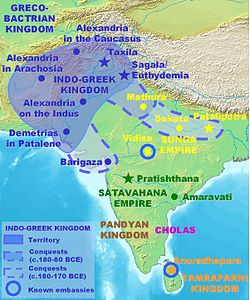อาณาจักรอินโด-กรีก
อาณาจักรอินโด-กรีก (อังกฤษ: Indo-Greek Kingdom) หรือในประวัติศาสตร์เรียก อาณาจักรยวนะ (ยวนราชยะ)[3] เป็นอาณาจักรกรีกสมัยเฮลเลนิสต์ที่ครอบคลุมพื้นที่หลายส่วนของประเทศอัฟกานิสถานและภูมิภาคตะวันตกเฉียงเหนือของอนุทวีปอินเดียในปัจจุบัน[4][5] อาณาจักรนี้ดำรงอยู่นาน 2 ศตวรรษ มีผู้ปกครองกว่า 30 องค์ และมีการผสานวัฒนธรรมกรีก-อินเดียทางด้านภาษา สัญลักษณ์ และแนวคิด ดังที่ปรากฏบนเหรียญและแหล่งขุดค้นโบราณคดี[6] การหลอมรวมนี้ส่งผลต่อมาโดยเฉพาะอย่างยิ่งศิลปะพุทธแบบกรีก[7]
อาณาจักรอินโด-กรีก | |||||||||||
|---|---|---|---|---|---|---|---|---|---|---|---|
| 200 ปีก่อนคริสตกาล–ค.ศ. 10 | |||||||||||
ช้างและเทพีไนกี เป็นสัญลักษณ์ที่ผู้ปกครองอินโด-กรีกใช้แพร่หลาย
| |||||||||||
 อาณาจักรอินโด-กรีกและเหตุการณ์สมัยที่พระเจ้ามิลินท์ปกครอง ประมาณ 165 ปีก่อนคริสตกาล | |||||||||||
| เมืองหลวง | อะเล็กซานเดรียในคอเคซัส (บากรามในปัจจุบัน) [1] ตักศิลา | ||||||||||
| ภาษาทั่วไป | ภาษากรีก (ชุดตัวอักษรกรีก) ภาษาบาลี (อักษรขโรษฐี) ภาษาสันสกฤต ภาษาปรากฤต (อักษรพราหมี) | ||||||||||
| ศาสนา | ศาสนาฮินดู พุทธนิกายมหายาน พหุเทวนิยมกรีก ศาสนาโซโรอัสเตอร์ | ||||||||||
| การปกครอง | ราชาธิปไตย | ||||||||||
| กษัตริย์ | |||||||||||
• 200 – 180 ปีก่อนคริสตกาล | เดเมตริอุสที่ 1 (องค์แรก) | ||||||||||
• 25 ปีก่อนคริสตกาล – ค.ศ. 10 | สตราโตที่ 3 (องค์สุดท้าย) | ||||||||||
| ยุคประวัติศาสตร์ | สมัยโบราณ | ||||||||||
• ก่อตั้ง | 200 ปีก่อนคริสตกาล | ||||||||||
• สิ้นสุด | ค.ศ. 10 | ||||||||||
| พื้นที่ | |||||||||||
| 150 ปีก่อนคริสตกาล[2] | 1,100,000 ตารางกิโลเมตร (420,000 ตารางไมล์) | ||||||||||
| |||||||||||
| ปัจจุบันเป็นส่วนหนึ่งของ | อัฟกานิสถาน อินเดีย ปากีสถาน เติร์กเมนิสถาน | ||||||||||
อาณาจักรอินโด-กรีกก่อตั้งขึ้นเมื่อเดเมตริอุส กษัตริย์กรีก-แบกเตรียรุกรานอินเดียเมื่อ 200 ปีก่อนคริสตกาล[8] ชาวกรีกในอนุทวีปอินเดียจึงแบ่งออกเป็นสองกลุ่มได้แก่ กลุ่มกรีก-แบกเตรียที่มีศูนย์กลางในแบกเตรีย (พรมแดนอัฟกานิสถาน–อุซเบกิสถานในปัจจุบัน) และกลุ่มอินโด-กรีกทางตะวันตกเฉียงเหนือของอนุทวีปอินเดีย ผู้ปกครองอินโด-กรีกที่มีชื่อเสียงที่สุดคือ พระเจ้ามิลินท์ ซึ่งมีเมืองหลวงอยู่ที่เมืองสาคละ (ปัจจุบันคือเมืองซิอัลโกต ประเทศปากีสถาน)[9][10]
ทั้งนี้คำว่า "อาณาจักรอินโด-กรีก" หมายความกว้าง ๆ ถึงกลุ่มราชวงศ์ที่หลากหลายจำนวนหนึ่งซึ่งมีเมืองหลวงประจำภูมิภาคหลายแห่ง เช่น ตักศิลา[11] สาคละ[12] และปุษกลาวตี นอกจากนี้อาจมีศูนย์กลางอื่น ๆ ดังที่ทอเลมีบันทึกใน จีออกราฟี ถึงทีโอฟิลอส กษัตริย์อินโด-กรีกที่ปกครองอยู่ทางใต้ของอาณาจักรเป็นเวลาสั้น ๆ และอาจเคยเป็นเซแทร็ปอยู่ช่วงหนึ่ง
หลังการสวรรคตของพระเจ้ามิลินท์ อาณาจักรของพระองค์ก็แตกแยกและอิทธิพลอินโด-กรีกลดลงอย่างสำคัญ กลุ่มอินโด-กรีกล่มสลายในฐานะหน่วยการเมืองราวค.ศ. 10 เมื่อถูกชาวอินโด-ไซเทีย ชนร่อนเร่ในเอเชียกลางกลุ่มหนึ่งรุกราน แต่ยังคงมีชาวกรีกจำนวนหนึ่งอาศัยอยู่ในอนุทวีปอินเดียต่อมา เมื่ออาณาจักรอินโด-พาร์เธียและจักรวรรดิกุษาณะเข้ามาปกครอง[13]
อ้างอิง แก้
- ↑ Tarn, William Woodthorpe (1966), "Alexandria of the Caucasus and Kapisa", The Greeks in Bactria and India, Cambridge University Press, pp. 460–462, doi:10.1017/CBO9780511707353.019, ISBN 9780511707353
- ↑ Taagepera, Rein (1979). "Size and Duration of Empires: Growth-Decline Curves, 600 B.C. to 600 A.D.". Social Science History. 3 (3/4): 132. doi:10.2307/1170959. JSTOR 1170959.
- ↑ Wilson, John (1877). Indian Caste (ภาษาอังกฤษ). Times of India Office. p. 353.
- ↑ Jackson J. Spielvogel (14 September 2016). Western Civilization: Volume A: To 1500. Cengage Learning. p. 96. ISBN 978-1-305-95281-2.
The invasion of India by a Greco-Bactrian army in ... led to the creation of an Indo-Greek kingdom in northwestern India (present-day India and Pakistan).
- ↑ Erik Zürcher (1962). Buddhism: its origin and spread in words, maps, and pictures. St Martin's Press. p. 45.
Three phases must be distinguished, (a) The Greek rulers of Bactria (the Oxus region) expand their power to the south, conquer Afghanistan and considerable parts of north-western India, and establish an Indo-Greek kingdom in the Panjab where they rule as 'kings of India'; i
- ↑ "A vast hoard of coins, with a mixture of Greek profiles and Indian symbols, along with interesting sculptures and some monumental remains from Taxila, Sirkap and Sirsukh, point to a rich fusion of Indian and Hellenistic influences", India, the Ancient Past, Burjor Avari, p. 130
- ↑ Ghose, Sanujit (2011). "Cultural links between India and the Greco-Roman world". Ancient History Encyclopedia
- ↑ Thonemann, Peter (2016-01-14). The Hellenistic World: Using Coins as Sources (ภาษาอังกฤษ). Cambridge University Press. p. 97. ISBN 978-1-316-43229-7.
- ↑ "Menander | Indo-Greek king". Encyclopedia Britannica (ภาษาอังกฤษ). สืบค้นเมื่อ 2021-09-06.
{{cite web}}: CS1 maint: url-status (ลิงก์) - ↑ Tarn, William Woodthorpe (2010-06-24). The Greeks in Bactria and India (ภาษาอังกฤษ). Cambridge University Press. p. 247. ISBN 978-1-108-00941-6.
- ↑ Mortimer Wheeler Flames over Persepolis (London, 1968). Pp. 112 ff. It is unclear whether the Hellenistic street plan found by Sir John Marshall's excavations dates from the Indo-Greeks or from the Kushans, who would have encountered it in Bactria; Tarn (1951, pp. 137, 179) ascribes the initial move of Taxila to the hill of Sirkap to Demetrius I, but sees this as "not a Greek city but an Indian one"; not a polis or with a Hippodamian plan.
- ↑ "Menander had his capital in Sagala" Bopearachchi, "Monnaies", p. 83. McEvilley supports Tarn on both points, citing Woodcock: "Menander was a Bactrian Greek king of the Euthydemid dynasty. His capital (was) at Sagala (Sialkot) in the Punjab, "in the country of the Yonakas (Greeks)"." McEvilley, p. 377. However, "Even if Sagala proves to be Sialkot, it does not seem to be Menander's capital for the Milindapanha states that Menander came down to Sagala to meet Nagasena, just as the Ganges flows to the sea."
- ↑ "When the Greeks of Bactria and India lost their kingdom they were not all killed, nor did they return to Greece. They merged with the people of the area and worked for the new masters; contributing considerably to the culture and civilization in southern and central Asia." Narain, "The Indo-Greeks" 2003, p. 278
